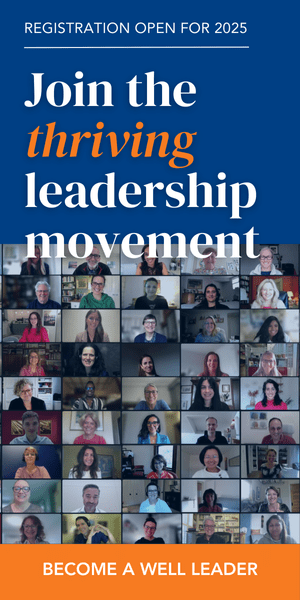 One of your roles as leader is to create the conditions where people, including yourself, can show up at the wisest and best. This is a strategic charge, yet most often brought to life in the daily realities of the job.
One of your roles as leader is to create the conditions where people, including yourself, can show up at the wisest and best. This is a strategic charge, yet most often brought to life in the daily realities of the job.
Because it is in those everyday moments that some of the most powerful leadership interventions can be applied—particularly the pattern interrupts that stop negative activity real-time before it becomes unmanageable. Here are three tangible examples from my own life:
- An executive team I recently supported was knee-deep into a conflict-ridden discussion, and at any moment, I could feel it going off the rails. Under-the-breath wisecracks, hand-wringing, grimaces, blank faces—all clues that things were falling apart at the seams. I felt that something needed to be done to get the collective energies of these leaders grounded and focused—where they partnered to resolve the conflict, rather than muscled for airtime or withdrew altogether. I called for a break, then led the group in a 5-minute breathing practice (4 X 8, described below). The energetic shift was immediate and palpable; it opened the door for these leaders to engage in an entirely different and, more importantly, deeper dialogue.
- I was tapped to provide the keynote at a consortium of global colleagues. Even though I’ve done speaking engagements for close to thirty years, those familiar pre-performance jitters cropped up—a knot in my stomach, buzzing in my head, my “what-if-they-find-out-I’m-a-sham” monkey mind. Instead of letting these symptoms of fear hijack me (I know from personal experience nothing good comes of that!), I spent 10 minutes doing a mindfulness practice (GETTING ALIGNED, described below). After it, my energy was working for—not against—me.
- Last week I gave 360-degree feedback to a senior leader. It was difficult; the huge gulf between his self-perception and the appraisal of him by his colleagues was a blow. His shock quickly turned into anxiety—How could I have been so wrong about myself? How could they say that about me? Will I lose my job? I recognized the feedback conversation would go nowhere unless he could reset emotionally, so I guided him in a quick centering practice (HAND ON HEART, described below). It transformed the quality of our conversation and revealed new actions he could imagine for personal and professional growth.
WHEN STOPPING ACTION IS YOUR BEST BET
It is exhausting to try to willpower results (believe me, I know) particularly when things are going awry. Fortunately, pushing things forward is not your only leadership move. In fact, stopping action may be your best bet when you notice any of these signs in meetings and conversations:
- Although the energy of people is high, it is chaotic and dispersed
- The conversation is going in circles, and could quickly devolve into a downward spiral
- The strain people feel is evident—and you know this stressed-out state will disable brighter thinking
- People are disengaging from the interactions altogether
THREE PRACTICES FOR INTERRUPTING THE NEGATIVE FLOW
When a meeting or conversation is going nowhere positive, why continue hammering away at it? Here are three practices to explore instead. I like these practices personally because they are quick, easy to learn, and easy to use. Plus, these practices support a transformative change in physiology of everyone who engages—from fight-or-flight sympathetic reaction to the relaxation and equilibrium of the parasympathetic response of the nervous system. This facilitates a consciousness shift as well, both for individuals and the group, more conducive to generative thinking and action.
- 4 X 8: Close your eyes or find a stationary point on which to rest your gaze. Inhale to count of 4. Briefly pause at the top of the breath. Exhale to count of 8. Repeat for at least three cycles, and notice the effects of this breath on your mind, energy, body, and emotions.
- Getting Aligned: Close your eyes or find a stationary point on which to rest your gaze. Inhale while gently lifting the crown of your head toward the sky. Exhale while allowing your hips to sink into your chair (if sitting) or soles of your feet to press into the floor (if standing). Repeat this cycle at least three times, lengthening your spine as you breathe and relax.
- Hand on Heart: Close your eyes or find a stationary point on which to rest your gaze. Take at least three deep breaths, placing one or both hands on top of your chest. Allow this touch to help you reconnect with your heart: its rhythm and beat, its qualities of lovingkindedness and care. Notice the effects of this action on your mind, emotions, body, and energy.
MAKE IT PART OF HOW YOU LEAD
I believe people are generally showing up the best they can based on their beliefs, capabilities, and circumstances. Regardless, things sometimes go amiss. Part of being a leader is to recognize these breakdowns and, when appropriate, to intervene with clarity, courage, and compassion. Make these three simple practices part of your leadership toolkit for stopping action to better results in your teams—and for yourself.
When you experiment with these (or like) practices, please let me know how it goes!!
Would you like to learn more leadership practices for elevating consciousness, thriving, and performance for you and your organization? Please contact me at renee@wisdom-works.com.
READ MORE
- The Pivot That Turns Challenge Into Growth: What These Women Inspiring Women Know
- Ready To Disrupt Yourself On Purpose? Try Uncentering!
- Leadership For Thriving Inside And Out
- What Effective Leaders Know In Their Bones: The 6 Powers of Thriving
- Your Inner Game Runs Your Outer Game
- Shifting From Reactivity To Wellbeing
- The Path Of The Evolving Leader: Leadership As Practice
- Is The Planet Ready For A Different Way Of Leading?
- Leading From Authenticity: Boosting Your Energy, Impact, and Wellbeing






